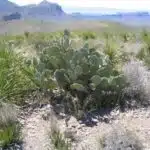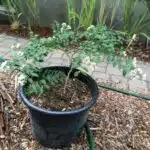The Texas Mountain Laurel (Sophora secundiflora) is a beautiful and fragrant evergreen shrub or small tree native to the southwestern United States. It is also known as mescal bean, frijolito, and fréjolillo. The plant produces clusters of purple-blue flowers that resemble grape hyacinths in early spring, followed by long seed pods. The foliage is glossy green and leathery, making it an attractive addition to any landscape.
Growing and caring for the Texas Mountain Laurel requires a bit of attention to detail, but the results are well worth it. This hardy plant can withstand drought conditions and extreme temperatures, making it an ideal choice for those looking for low-maintenance landscaping options. However, proper soil preparation, watering techniques, and pruning practices are essential to ensure healthy growth and longevity of this beautiful plant. In this article, we will provide you with all the information needed to grow and care for Texas Mountain Laurel successfully.
Understanding The Texas Mountain Laurel Plant
The Texas Mountain Laurel is an evergreen shrub that is native to the southwestern United States. It is known for its beautiful, fragrant flowers that bloom in the spring, as well as its hardy nature and drought tolerance. This plant can grow up to 30 feet tall and has a spread of up to 20 feet, making it an excellent choice for landscaping and gardening.
Understanding pruning techniques for the Texas Mountain Laurel plant is crucial for promoting healthy growth and maintaining its shape. Pruning can be done in late winter or early spring before new growth begins. It involves removing any dead, damaged, or diseased branches while shaping the plant to your desired form. When pruning, be sure to use clean, sharp tools to prevent damage to the plant’s bark.
Identifying common diseases that may affect your Texas Mountain Laurel plant can help you take preventative measures to keep it healthy. One disease that affects this plant is called oak root fungus, which attacks the roots of many plants in the same family as the Texas Mountain Laurel. Symptoms of this disease include yellowing leaves and wilting branches. To prevent oak root fungus from affecting your plant, make sure it is planted in well-draining soil and avoid over-watering.
Choosing The Right Location For Your Plant
Choosing the ideal location for your Texas mountain laurel is essential for its optimal growth and thriving. These plants love full sun, so it’s vital to choose a spot in your garden that receives at least six hours of direct sunlight per day. The best location would be one that gets morning sun and afternoon shade as this will protect the plant from the scorching heat during the hottest part of the day.
When selecting a spot in your garden, consider how much space you have available. Texas mountain laurels can grow up to 15 feet tall and 10 feet wide, so make sure you have enough room for them to spread out. It’s also important to note that these plants prefer well-draining soil, so avoid areas where water tends to accumulate or get bogged down.
To evoke an emotional response from our audience, here are some reasons why choosing the right location for your Texas mountain laurel is crucial:
- A healthy plant brightens up any garden and adds to the beauty of nature around us.
- By providing optimal conditions for growth, we are showing care and attention towards our plants, which can be therapeutic and calming.
- Growing a Texas mountain laurel in your garden allows you to contribute positively towards conservation efforts as they are native plants that attract pollinators such as bees and butterflies.
To ensure your Texas mountain laurel thrives in its new location, soil preparation is critical. In the next section, we’ll discuss how to prepare the soil properly before planting your new addition to the garden.
Soil Preparation For Optimal Growth
When it comes to growing Texas Mountain Laurel, soil preparation is crucial for optimal growth. As the saying goes, “you reap what you sow,” and this holds true for gardening as well. The first step in preparing the soil is to remove any weeds or rocks that may obstruct the growth of the plant. Once cleared, composting techniques can be used to enrich the soil with organic matter and provide essential nutrients for the plant’s growth.
Mulching benefits cannot be overstated when it comes to growing Texas Mountain Laurel. Mulch helps retain moisture in the soil while also preventing weed growth and regulating soil temperature. Organic mulches such as pine needles or bark chips are recommended, as they will decompose over time and further enrich the soil with organic matter.
In addition to these techniques, it is important to monitor soil pH levels to ensure that it is within a range of 6-8. If necessary, amendments can be added to adjust pH levels accordingly. By taking these steps in preparing the soil, gardeners can ensure optimal growth of their Texas Mountain Laurel plants.
Moving forward into watering techniques and frequency, it is important to note that proper watering is just as crucial as soil preparation for healthy plant growth.
Watering Techniques And Frequency
Texas Mountain Laurels are sensitive to over or under-watering, and require careful observation to ensure that their needs are met. The frequency of watering should be determined by the soil type, temperature, and light exposure of the plant. To water Texas Mountain Laurels, it is recommended to deliver water directly to the root system, rather than to the foliage, as this can cause fungal diseases. Additionally, the amount of water provided should be adjusted according to the size of the plant; a larger plant will require more water than a smaller one.
Watering Frequency
Watering is one of the most crucial aspects of growing and caring for Texas Mountain Laurel. As a horticulturist, it is essential to understand the best watering techniques to ensure that your plant thrives. Texas Mountain Laurels have a high drought tolerance, which means they can survive long periods without water. However, it’s vital not to overwater them as this can lead to root rot.
To determine the right watering frequency for your Texas Mountain Laurel, you need to consider factors such as soil type, weather conditions, and the age of the plant. During the first few months after planting, your plant will require more frequent watering as its roots are still establishing themselves in the soil. Once established, Texas Mountain Laurels need infrequent deep watering rather than shallow and frequent watering. It’s best to water deeply once every two weeks during dry spells.
In conclusion, understanding proper watering techniques is crucial in growing and caring for Texas Mountain Laurels. Overwatering should be avoided at all costs while ensuring that your plant receives enough water through deep watering every two weeks during dry spells. By following these tips on watering frequency and techniques, you’ll be able to ensure that your Texas Mountain Laurel thrives beautifully for years to come.
Watering Techniques
Watering techniques are essential to ensure that Texas Mountain Laurels thrive beautifully. Deep watering is a recommended technique that promotes the growth of healthy roots while conserving water. It involves watering the plant until the soil is moistened to a depth of at least six inches. This technique encourages deep root growth and improves drought tolerance, enabling the plant to survive long periods without water.
To achieve deep watering, you can use a soaker hose or drip irrigation system. These methods allow water to penetrate deeply into the soil and reach the roots, reducing runoff and evaporation. Additionally, mulching around your Texas Mountain Laurel helps retain moisture in the soil, minimizing water loss through evaporation.
Understanding proper watering techniques ensures that Texas Mountain Laurels thrive in all weather conditions. With their high drought tolerance, infrequent deep watering is ideal for these plants. By incorporating deep watering techniques and using appropriate irrigation systems, you can promote healthy root growth and ensure that your Texas Mountain Laurel thrives beautifully for years to come.
Fertilizing Your Texas Mountain Laurel
Fertilizing your Texas Mountain Laurel is an essential aspect of growing and caring for this plant. Choosing the right type of fertilizer can make a significant difference in its growth and overall health. Organic fertilizers are made from natural sources, such as animal products, while synthetic fertilizers are manufactured chemically.
Organic fertilizers are a better choice for Texas Mountain Laurels because they contain essential nutrients that feed the soil over time, allowing the plant to absorb them gradually. They also improve soil structure and promote beneficial microbial activity in the soil. Synthetic fertilizers provide immediate results but do not benefit the soil in the long run.
Timing is crucial when fertilizing your Texas Mountain Laurel. It is best to apply fertilizer during its active growing season, which typically occurs in spring and summer. Avoid fertilizing during winter or fall, as this can stimulate new growth that may be damaged by frost or cold weather.
Transitioning to pruning and shaping your plant, it is important to note that improper pruning can lead to damage or even death of your Texas Mountain Laurel. Therefore, it is vital to understand how to prune your plant correctly.
Pruning And Shaping Your Plant
After fertilizing your Texas Mountain Laurel, it is essential to focus on pruning and shaping your plant. Pruning techniques can help maintain the overall health of your shrub while promoting its growth and appearance. Shaping tools such as pruning shears or loppers are required to trim any dead or diseased branches.
When pruning, always remember to remove any suckers from the base of the plant as well as any crossing or rubbing branches that may cause damage to the tree. It is best to prune in late winter or early spring before new growth appears. Make sure to use clean, sharp tools and cut at a 45-degree angle just above a bud.
To shape your Texas Mountain Laurel, consider using techniques such as thinning, heading back, or selective pruning. Thinning involves removing entire branches from the base, while heading back means cutting back a branch to a bud or side shoot. Selective pruning involves removing specific parts of the plant for aesthetic purposes. By implementing these techniques correctly, you can create a beautiful and healthy shrub that adds value to your garden.
To further care for your Texas Mountain Laurel, it is crucial to know how to deal with pests and diseases that may affect your plant’s growth in the future.
Dealing With Pests And Diseases
Texas mountain laurel is generally a hardy plant that can thrive in various conditions, but it is not immune to pests and diseases. The most common pest that affects Texas mountain laurel is the Genista caterpillar. These pests are known to feed on the leaves of the plant and can cause significant damage if left unchecked. Other pests that may attack this plant include spider mites, aphids, and scale insects.
One of the most effective ways to deal with these pests is by using natural remedies. This approach involves using organic methods to control pest infestations without harming the environment or other beneficial insects. For instance, you can use neem oil, which is a natural insecticide that repels or kills many types of pests. Alternatively, you can create a solution of water and soap and spray it on the affected parts of the plant.
If natural remedies fail to work, chemical treatments may be necessary as a last resort. However, it’s important to note that some chemicals may be harmful to beneficial insects such as bees and butterflies. If you must use chemicals, make sure to choose those that target specific pests while sparing beneficial insects. Additionally, always follow the instructions on the label carefully to avoid harming yourself or others.
To ensure your Texas mountain laurel remains healthy and disease-free, you should inspect it regularly for any signs of damage or infestations. By catching problems early on, you’ll be able to address them before they become more serious issues that are harder to control. In the next section, we will discuss propagation methods for Texas mountain laurel so you can grow more plants in your garden.
Propagation Methods
As we have discussed in the previous section, pests and diseases can be a major concern for Texas Mountain Laurel owners. However, with proper care and attention, these issues can be minimized. Now let’s move on to the next important topic: propagation methods.
Growing from seeds is one of the most common ways to propagate Texas Mountain Laurels. Seeds should be collected when they are ripe and planted in a well-draining potting mix or soil. Keep the soil moist and warm, and germination should occur within a few weeks. Alternatively, grafting techniques may be used to produce identical copies of an existing plant by attaching a cutting from that plant onto rootstock.
Propagation methods are essential for expanding your Texas Mountain Laurel collection or sharing them with friends and family. However, it is also important to consider the type of container you use for growing these plants. In the subsequent section, we will discuss container gardening with Texas Mountain Laurel and provide some tips on how to successfully grow this beautiful plant in pots or other containers.
Container Gardening With Texas Mountain Laurel
Growing Texas Mountain Laurel in containers is an excellent option for those who do not have enough space or are looking to decorate their patios, porches, or balconies. However, it is essential to choose the right container size to ensure that the plant has enough room for its roots to grow. A container with a diameter of at least 18 inches should suffice for a young Texas Mountain Laurel.
The potting mix you use for your Texas Mountain Laurel is equally important. Avoid using garden soil as it tends to be too heavy and may cause waterlogging, leading to root rot. Instead, opt for a well-draining potting mix that contains perlite, vermiculite, or sand. These materials will help improve soil drainage and aeration while also preventing the soil from becoming too compacted.
Watering schedule plays a vital role in container gardening. The ideal watering schedule for Texas Mountain Laurel is once every week during spring and summer months and once every two weeks during fall and winter months. Additionally, ensure that the container has adequate drainage holes at the bottom to prevent water from accumulating and causing root rot. By maintaining proper watering practices and ensuring adequate drainage, your container-grown Texas Mountain Laurel will thrive in its new environment.
Transition: Now that we’ve covered how to grow Texas Mountain Laurel in containers let’s move on to companion planting with this lovely plant species.
Companion Planting With Texas Mountain Laurel
Companion planting is a great way to enhance the beauty and health of your garden. When choosing companion plants for Texas Mountain Laurel, it is important to consider the growing conditions and needs of both plants. One of the best plant pairings for Texas Mountain Laurel is the Blackfoot Daisy. This low-growing perennial requires similar soil conditions and can tolerate full sun, making it an excellent complement to the drought-tolerant Texas Mountain Laurel.
Another great companion plant for Texas Mountain Laurel is the Agave Americana. Both plants have similar water requirements and thrive in full sun. The Agave Americana’s spiky leaves add texture and contrast to the smooth, glossy foliage of the Texas Mountain Laurel. Additionally, planting these two together creates a beautiful southwestern landscape design.
When selecting companion plants for Texas Mountain Laurel, it is essential to choose those that can thrive in its growing conditions and complement its aesthetic qualities. Other excellent options include Cenizo or Texas Sage, Mexican Buckeye, and Little Bluestem grasses. By following these companion planting tips, you can create a stunning garden filled with colorful blooms, interesting textures, and unique shapes that will elevate your outdoor space.
Transition: Now that you know about some of the best plant pairings for Texas Mountain Laurel let’s move on to how you can use this beautiful shrub in your landscaping design.
Using Texas Mountain Laurel In Landscaping Design
Texas Mountain Laurel is a versatile plant that can be used in various landscape designs. Its unique shape, beautiful foliage, and fragrant flowers make it an excellent choice for garden arrangements. The plant’s evergreen nature allows it to maintain its beauty throughout the year.
One popular way to use Texas Mountain Laurel in landscaping design is as a focal point. Its striking appearance makes it an ideal centerpiece for any garden or yard. Additionally, the plant can be used as a hedge to provide privacy or as a backdrop for other plants.
Another way to incorporate Texas Mountain Laurel in your landscape design is by mixing it with other plants. The plant’s purple flowers and green foliage blend well with other flowering plants such as roses and lilies. Pairing it with succulents or cacti can also create an interesting contrast in texture and color.
As you plan your landscape design, consider including Texas Mountain Laurel for its unique beauty and versatility. With its striking appearance and ability to thrive in various conditions, this plant will make an excellent addition to any garden arrangement.
Transition: Now that you have learned how to use Texas Mountain Laurel in your landscape design, let us discuss how to care for the plant during winter months.
Winter Care And Protection
As winter approaches, it is important to ensure that your Texas Mountain Laurel shrub is well-protected. This is especially true if you live in an area that experiences harsh winter conditions. Here are some tips on how to properly care for your shrub during the colder months.
Firstly, covering leaves can provide protection from frost and wind damage. You can use a burlap cover or any other breathable material to drape over the leaves of your shrub. This helps to maintain humidity levels around the plant while still allowing air circulation. Additionally, mulching techniques can help prevent soil erosion and retain moisture around the roots of the tree.
Secondly, frost protection is essential for Texas Mountain Laurel shrubs during winter. Applying a layer of straw or pine needles around the base of your plant will help insulate it from cold temperatures. You can also wrap the trunk with a protective covering made of burlap or other materials to keep it warm.
Lastly, winterizing tips include watering your shrub deeply before the first freeze and avoiding fertilization until spring. It’s also important to prune away any dead or damaged branches before winter sets in.
Following these tips will help ensure that your Texas Mountain Laurel thrives throughout the winter months.
Markdown List:
- Use a burlap cover or breathable material to protect leaves
- Mulching techniques prevent soil erosion and retain moisture
- Apply protective straw or pine needle layer for frost protection
- Prune away dead or damaged branches before winter
The health and well-being of your Texas Mountain Laurel is vital, especially when it comes to cold weather conditions. By following these simple winter care techniques such as covering leaves, using mulching techniques and providing frost protection you can protect this beautiful shrub from harsh weather elements all season long! In our next section we will explore common myths and misconceptions about Texas Mountain Laurels.
Common Myths And Misconceptions About Texas Mountain Laurel
Texas Mountain Laurel is a stunning evergreen shrub, often found in Texas yards. However, there are several common myths and misconceptions about growing and caring for this species. Overwatering Texas Mountain Laurel can cause root rot and other issues. Pruning of Texas Mountain Laurel needs to be done in late winter or early spring as flower buds are set in the summer. Texas Mountain Laurel should be grown in full sun, or in part shade in areas with hot summers. Too much shade can cause the plant to become leggy and sparse.
Overwatering
As horticulturists, we understand that plants have specific watering needs to grow and thrive. One common myth about Texas Mountain Laurel is that it requires frequent watering, which can ultimately harm the plant. Preventing overwatering is crucial in maintaining a healthy Texas Mountain Laurel.
Overwatering can lead to root rot, fungal infections, and stunted growth. Signs of overwatering include yellow or wilted leaves, stunted growth, and soil that remains constantly wet. To prevent overwatering, ensure that the soil has proper drainage and only water when the top inch of soil feels dry to the touch.
In summary, it is important to dispel the myth that Texas Mountain Laurel requires frequent watering. Overwatering can harm the plant’s growth and health by causing root rot and fungal infections. Pay attention to signs of overwatering and only water when necessary to keep your Texas Mountain Laurel thriving.
Pruning
Pruning is an essential aspect of maintaining the health and beauty of Texas Mountain Laurel. However, there are several myths surrounding pruning techniques that may harm the plant’s growth. One common misconception is that Texas Mountain Laurel does not require pruning, which can lead to a dense and unattractive appearance. Pruning can help maintain a desirable shape, promote flowering, and increase air circulation.
It is crucial to follow a proper maintenance schedule when it comes to pruning Texas Mountain Laurel. The best time to prune is after the plant has finished blooming in late spring or early summer. This allows for new growth and prevents damage to new buds forming for next year’s bloom cycle. Additionally, it is recommended to remove only one-third of the plant’s total foliage at any given time to avoid stress and shock.
When it comes to pruning techniques, it is important to use clean and sharp tools to prevent tearing or crushing the plant’s tissue. Remove any dead or damaged branches first, followed by any crossing or rubbing branches that may damage each other over time. Finally, trim back any overly long branches that disrupt the desired shape of the plant. With proper pruning techniques and maintenance scheduling, your Texas Mountain Laurel will thrive for years to come.
Sunlight Requirements
Sun exposure is an essential aspect of plant growth, and Texas Mountain Laurel is no exception. Contrary to popular belief, Texas Mountain Laurel requires full sun exposure to thrive. This means that the plant needs at least six hours of direct sunlight per day to maintain its health and beauty. Insufficient sun exposure can lead to poor flowering, stunted growth, and an overall unhealthy appearance.
Another common myth surrounding Texas Mountain Laurel’s sunlight requirements is that shading is beneficial for the plant. However, this couldn’t be further from the truth. Shading can cause a lack of air circulation around the plant’s foliage, leading to increased humidity levels and potential fungal diseases. Furthermore, shaded plants tend to grow tall and lanky as they stretch towards the available light source, resulting in a weak structure that cannot support heavy flowering.
To ensure optimal growth and health, it is crucial to provide your Texas Mountain Laurel with full sun exposure. If your plant is currently growing in a shaded area, consider transplanting it to a spot with more sunlight. Additionally, avoid planting other trees or structures that may shade the plant over time. By providing adequate sun exposure, you can enjoy a beautiful and healthy Texas Mountain Laurel for years to come.
Frequently Asked Questions About Texas Mountain Laurel
Contrary to popular belief, Texas Mountain Laurel is not a type of laurel but belongs to the Fabaceae family. It is a small tree that can grow up to 30 feet tall with dark green leaves and beautiful purple flowers. The plant is native to Texas and is known for its sweet fragrance and ornamental value.
The growing season for Texas Mountain Laurel is from late winter to early spring when the plant starts producing new growth. The tree thrives in well-drained soil, full sun exposure, and moderate watering during its growing period. Overwatering can lead to root rot; therefore, it’s essential to allow the soil to dry out between watering sessions. Additionally, fertilizing once every year in early spring with a balanced fertilizer will help maintain the plant’s health.
Common issues that affect Texas Mountain Laurel include fungal diseases such as verticillium wilt and oak root fungus. These diseases cause wilting of leaves and eventual death of the plant. To prevent these diseases from infecting your tree, ensure adequate drainage in the soil, avoid overwatering, and prune infected branches immediately. Pest infestations are rare but can be controlled using insecticidal soap or neem oil spray if detected early enough.
Additional resources for Texas Mountain Laurel care and maintenance include horticultural societies such as the Native Plant Society of Texas, local nurseries that specialize in native plants, or gardening books on desert plants. These resources provide in-depth information on how best to care for your tree by providing tips on pruning techniques, pest control methods, and general maintenance practices. With proper care and attention, your Texas Mountain Laurel will thrive for many years to come!
Additional Resources For Texas Mountain Laurel Care And Maintenance
Expanding your knowledge of Texas Mountain Laurel care and maintenance can be done through various resources. Online forums, such as GardenWeb, offer a platform for gardeners to exchange information about their experiences with the plant. These forums provide valuable insights into the common issues that arise during cultivation, and how they can be tackled.
Attending gardening workshops is another effective way to gain knowledge on caring for Texas Mountain Laurel. These events are usually hosted by experts in the field who share their expertise on growing, pruning, fertilizing and other aspects of cultivating this plant. Workshops also provide an opportunity to connect with fellow gardeners and learn from their experiences.
In addition to online forums and workshops, there are numerous books and articles available that delve into the specifics of Texas Mountain Laurel care. These resources can help you understand the nuances of cultivating this plant according to your region’s climate, soil type and other factors. With a bit of research and dedication, you can become an expert in caring for Texas Mountain Laurel, resulting in a beautiful landscape that will enhance your home’s beauty for years to come.
Conclusion
The Texas Mountain Laurel is a stunning and hardy plant that can add beauty and fragrance to any garden. As a horticulturist, it is my pleasure to share with you the best practices for growing and caring for this remarkable shrub.
To ensure optimal growth, it is important to select the right location and prepare the soil accordingly. Proper watering techniques, fertilization, and winter care are also essential for maintaining a healthy plant. Additionally, there are common myths and misconceptions about this species that need to be dispelled.
In conclusion, the Texas Mountain Laurel is a wonderful addition to any garden or landscape. With proper care and maintenance, it can thrive and bring joy for many years to come. As horticulturists, it is our responsibility to educate ourselves on these plants so that we can help preserve their beauty and importance in our environment. So let us all do our part in nurturing these majestic shrubs like the delicate gems they truly are.
Image Credits
- “Texas Mountain Laurel” by charkesw (featured)





























